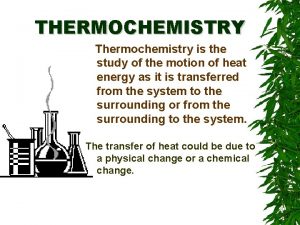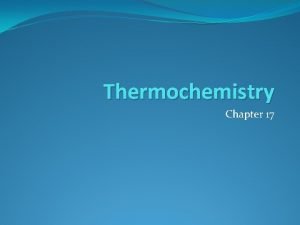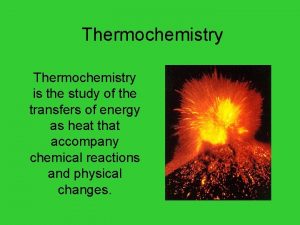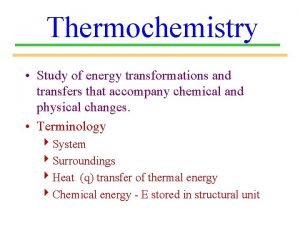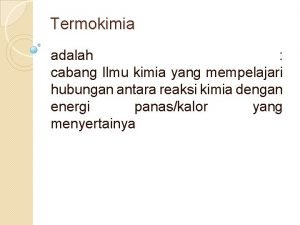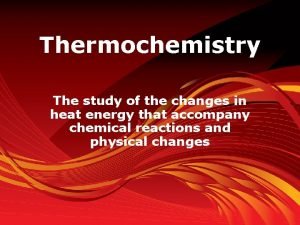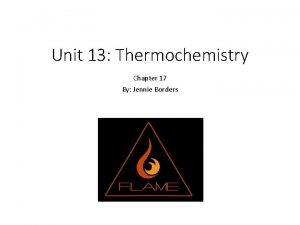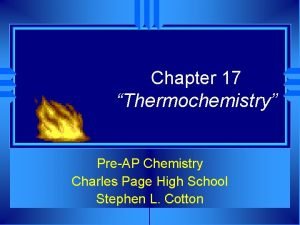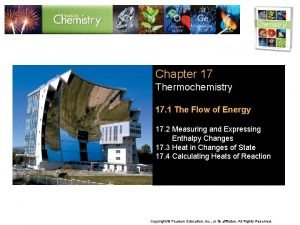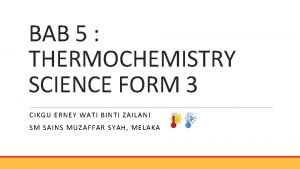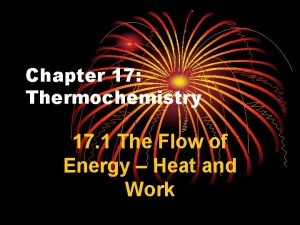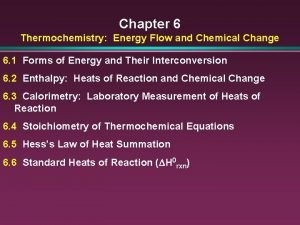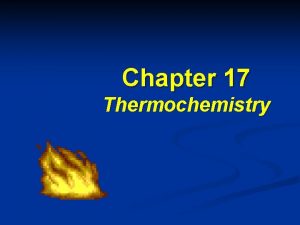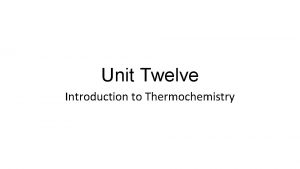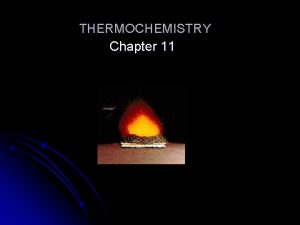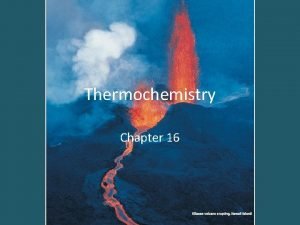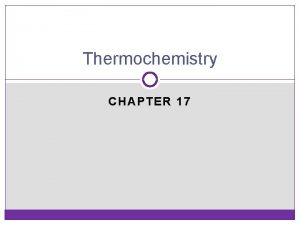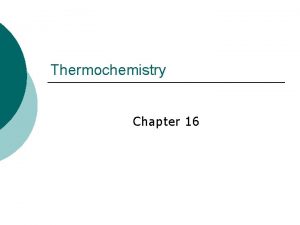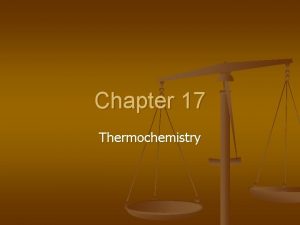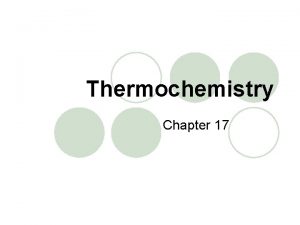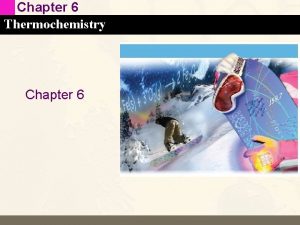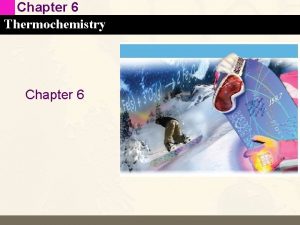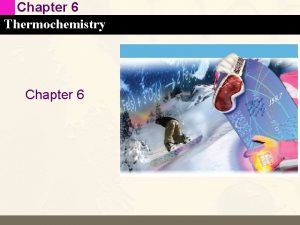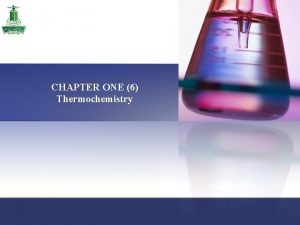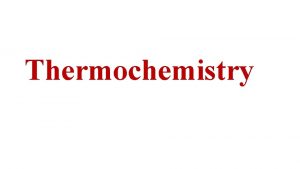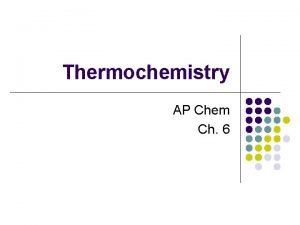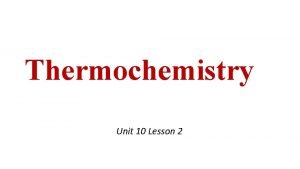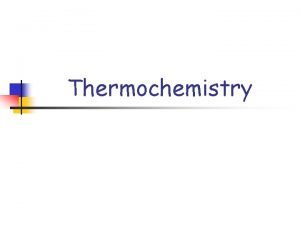Thermochemistry Chapter 17 Thermochemistry is the study of





























- Slides: 29

Thermochemistry Chapter 17

Thermochemistry is the study of heat changes that occur during chemical reactions.

Energy is the ability to do work or cause change. Work is force applied over a distance Potential Energy is stored energy Kinetic Energy is energy of motion Chemical Potential Energy is stored within the structural units of chemical substances.

Heat (q) is Energy that is transferred from one object to another Transfer is due to temperature difference between the two substances Heat ALWAYS travels from hot to cold Remember, temperature is a measure of the average kinetic energy of a substance

Heat CANNOT be detected. the changes CAUSED by heat however can be ex. Rise in temperature

Law of Conservation of Energy In any chemical or physical process, energy is neither created nor destroyed. All of the energy involved can be accounted for as Work, Potential Energy, or Heat.

Terms for studying heat: �System – what you are focusing on �Surroundings – everything else �Universe = System + Surroundings �Direction of heat flow is always described relative to the system. �Endothermic process – Energy is absorbed by the system from the surroundings (Heats up) �Exothermic process – Energy is released by the system into the surroundings (Cools down)

Endothermic vs. Exothermic Endothermic Lose Heat Gain Heat - q + q

Units of Heat �calorie- the quantity of heat needed to raise the temperature of 1 g of pure H 2 O 1 degree Celsius. �Calorie = 1000 calories = 1 kilocalorie => Dietary Calorie �Joule – the quantity of heat needed to raise the temperature of 1 g of pure H 2 O, 0. 2390 degrees Celsius. � 4. 184 J = 1 cal

Heat Capacity vs. Specific Heat Capacity Heat capacity – the amount of heat needed to raise the temperature 1 degree Celsius, for any substance Depends on mass and composition Specific heat capacity (specific heat) – the amount of heat it takes to raise the temperature of 1 g of a substance 1 degree Celsius. Depends on composition only

Calculation Specific heat = Heat_______ Mass x Change in Temperature Specific heat (C or Cp) Heat (q) Mass (m) Change in temperature ( ∆T) q = m C ∆T

Measuring and Expressing Heat Changes (change in temperature) Calorimetry- Accurate and precise measurement of heat change Instrument – Calorimeter For systems at constant pressure, the heat content is the same as enthalpy (H) Heat changes are the same as changes in enthalpy (ΔH) q = ΔH Since q = ΔH, then by substitution ΔH = m x C x ΔT

Heat in Changes of State Molar Heat of Fusion (ΔHfus) – Solid to Liquid Molar Heat of Vaporization (ΔHvap) – Liquid to Gas q = ΔH x mass OR q = ΔH x moles Depends on units of ΔH

Phase Change Diagram

Phase Changes

Group Concept Questions Your text defines energy as “the ability to do work or to cause change”. Another definition of energy is “the ability to resist a natural tendency”. Explain this definition and provide an example. A friend of yours reads that the process of water freezing is exothermic. This friend tells you that this can’t be true because exothermic implies “hot”, and ice is cold. Is the process of water freezing exothermic? If so, explain it so your friend can understand it. If not, explain why not.

Group Concept Questions You place hot metal into a beaker of cold water. Eventually what is true about the temperature of the metal compared to that of the water? Explain why this is true. Label this process as endothermic or exothermic if we consider the system to be: the metal. Explain the water. Explain

Group Concept Questions The text describes the law of conservation of energy. Is there a law of conservation of heat? Explain why or why not. What does it mean when the heat for a process is reported with a negative sign? You place 100. 0 g of a hot metal in 100. 0 g of cold water. Which substance (metal or water) undergoes a larger temperature change? Why is this?

Group Concept Questions A desert is very hot during day but quite cold at night. In the Midwest of the United States, the temperature is more constant between day and night in the summer. Why is this? Explain why aluminum cans make good storage containers for soft drinks.

Calorimetry Problems: Changes in Temperature How much heat is absorbed by 60. 0 g of copper when its temperature is raised from 20 o. C to 80 o. C? What is the specific heat of a 124 g sample of brass if 3. 94 x 103 J raises the temperature of the brass from 12. 5 o. C to 97. 0 o. C? If 350 J of heat energy are added to 100 g of a metal and the temperature changes by 25 o. C, what is the specific heat of the metal? What is the identity of the metal? 10 g of an unknown metal requires 39 J of energy to increase its temperature from 50 o. C to 60 o. C. What is

Calorimetry Problems: Heat Lost = Heat Gained When 80. 0 grams of a certain metal at 90. 0 °C was mixed with 100. 0 grams of water at 30. 0 °C, the final equilibrium temperature of the mixture was 36. 0 °C. What is the specific heat of the metal? Calculate the specific heat of a metal if a 55. 0 g sample of an unknown metal at 99. 0 °C causes a 1. 7 °C temperature rise when added to 225. 0 g of water at 22. 0 °C.

Calorimetry Problems: Heat Lost = Heat Gained A piece of an unknown metal with mass 23. 8 g is heated to 100. 0ºC and dropped into 50. 0 cm 3 of water at 24. 0ºC. The final temperature of the system is 32. 5ºC. What is the specific heat of the metal? A blacksmith heated an iron bar to 1445ºC. The blacksmith then tempered the metal by dropping it into 42, 800 m. L of water that had a temperature of 22ºC. The final temperature of the system was 45ºC. What was the mass of the bar? Note: Specific heat of iron is 0. 4494 J/g·Cº.

Energy and Reactions How does ENERGY affect REACTIONS

Enthalpy The amount of energy gained or released in a reaction is the ENTHALPY (∆H). ALL reactions require energy to occur. The amount of energy needed to occur is called the ACTIVATION ENERGY. The more energy required for the reaction to occur, the less likely the reaction will happen. Because of the energy released in exothermic reactions, exothermic reactions are more likely to occur than endothermic reactions. In other words, they are more spontaneous.

Exothermic and Endothermic Reactions

Catalysts speed up reactions by lowering the activation energy required for the reaction to occur. Enzymes are biological catalysts. Most catalysts work by helping ions and molecules to “line up” the right way so they can react. http: //www. dlt. ncssm. edu/tiger/Flash/kinetics/Enzyme. Catalyst. html

Reaction Path

Entropy Whether or not a reaction will occur depends on both ENTHALPY and ENTROPY. Entropy is a measure of disorder. Increasing disorder is a spontaneous process. Entropy of States: solid < liquid < gas Kinetic. . Energy – Gas Kinetic Energy – Liquid Kinetic Energy – Solid Mixing substances, combining or separating elements, and changing the temperature can affect the level of disorder as well. Mixing gases

Spontaneous? If energy is released and disorder is increased, the reaction will be spontaneous. In other words, it will happen “on its own. ” If energy is absorbed and disorder decreases, the reaction will be non-spontaneous. These reactions will need “help” to occur. They can’t do it by themselves. If one factor is favorable and one is unfavorable, then spontaneity will depend on the values of enthalpy and entropy.
 Thermochemistry is the study of
Thermochemistry is the study of Thermochemistry is study of
Thermochemistry is study of Thermochemistry is a study of
Thermochemistry is a study of Thermochemistry is the study of *
Thermochemistry is the study of * Study of energy and its transformations
Study of energy and its transformations Termokimia adalah cabang ilmu kimia yang mempelajarai ... *
Termokimia adalah cabang ilmu kimia yang mempelajarai ... * Thermochemistry is study of
Thermochemistry is study of Thermochemistry is the study of
Thermochemistry is the study of Chapter 17 thermochemistry practice problems answers
Chapter 17 thermochemistry practice problems answers Chapter 17 thermochemistry
Chapter 17 thermochemistry Chapter 17 thermochemistry answer key
Chapter 17 thermochemistry answer key Science form 3 chapter 5 exercise with answers
Science form 3 chapter 5 exercise with answers Quiz 2: heat flow and technology
Quiz 2: heat flow and technology Chapter 6 thermochemistry
Chapter 6 thermochemistry Chapter 17 thermochemistry
Chapter 17 thermochemistry Hình ảnh bộ gõ cơ thể búng tay
Hình ảnh bộ gõ cơ thể búng tay Frameset trong html5
Frameset trong html5 Bổ thể
Bổ thể Tỉ lệ cơ thể trẻ em
Tỉ lệ cơ thể trẻ em Voi kéo gỗ như thế nào
Voi kéo gỗ như thế nào Tư thế worm breton là gì
Tư thế worm breton là gì Hát lên người ơi
Hát lên người ơi Các môn thể thao bắt đầu bằng tiếng bóng
Các môn thể thao bắt đầu bằng tiếng bóng Thế nào là hệ số cao nhất
Thế nào là hệ số cao nhất Các châu lục và đại dương trên thế giới
Các châu lục và đại dương trên thế giới Công thức tính độ biến thiên đông lượng
Công thức tính độ biến thiên đông lượng Trời xanh đây là của chúng ta thể thơ
Trời xanh đây là của chúng ta thể thơ Mật thư anh em như thể tay chân
Mật thư anh em như thể tay chân Phép trừ bù
Phép trừ bù Phản ứng thế ankan
Phản ứng thế ankan

